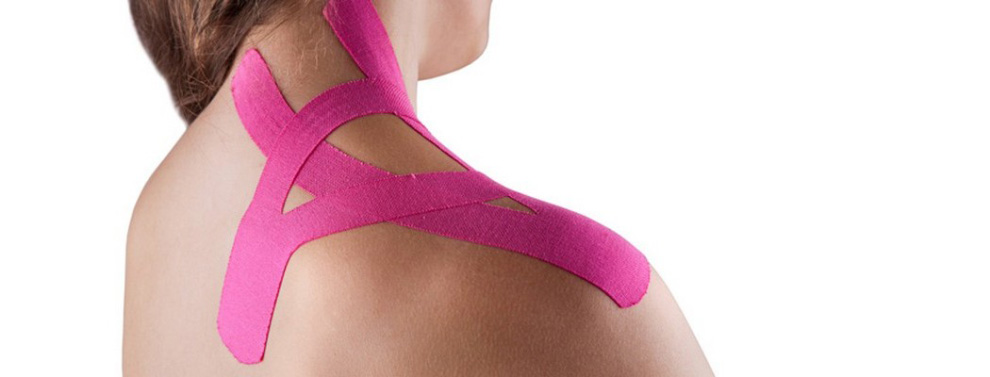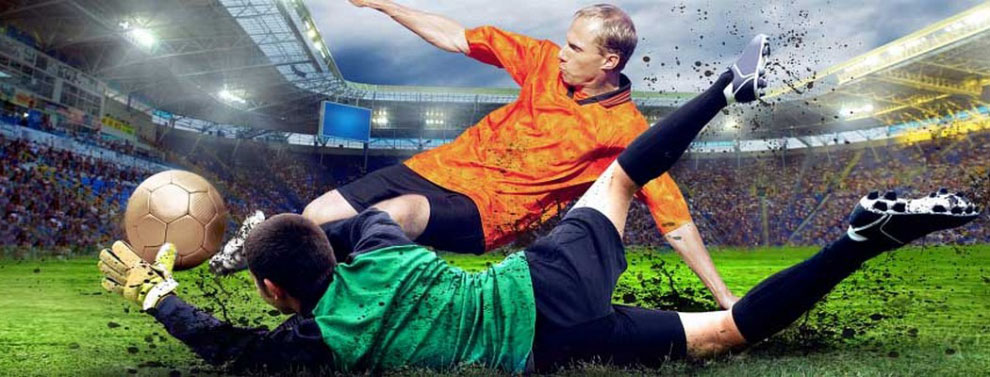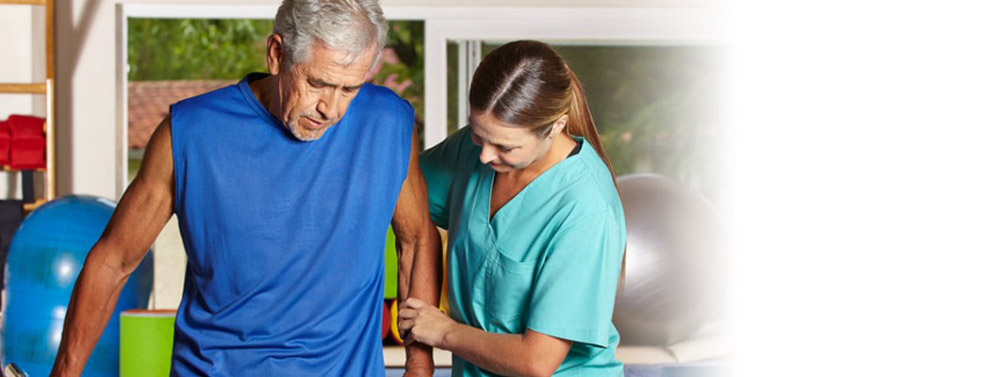Introduction
Physical therapy in Mount Airy for Pediatric Issues

Welcome to Northern Rehab’s guide to nursemaid's elbow.
Nursemaid’s elbow is a common injury in young children. It occurs most often around age two and is rarely seen after age eight. Lifting the child up a step by the hand, giving the hand a sudden jerk, or pulling the child away from a dangerous situation can result in a subluxation or complete dislocation of one of the bones in the elbow. This condition is also known as pulled elbow or radial head dislocation.
This guide will help you understand:
- what can cause this condition
- what the symptoms are
- how your health care professional will diagnose the condition
- what treatment options are available
- what Northern Rehab’s approach to rehabilitation is
#testimonialslist|kind:all|display:slider|orderby:type|filter_utags_names:Pediatrics|limit:15|heading:Hear from some of our *Pediatrics* patients#
Anatomy
What part of the elbow does this problem affect?
The bones of the elbow are the humerus (the upper arm bone), the ulna (the larger bone of the forearm, on the opposite side of the thumb), and the radius (the smaller bone of the forearm on the same side as the thumb).
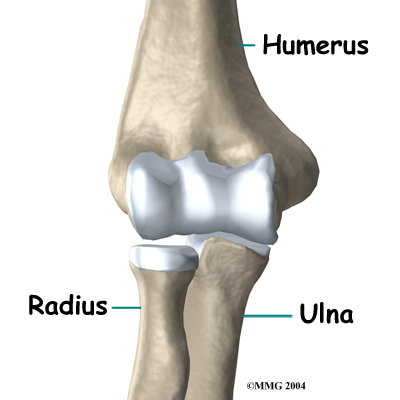
The elbow itself is essentially a hinge joint, meaning it bends and straightens like a hinge. But there is a second joint where the end of the radius (the radial head) meets the humerus. The knob on the end of the humerus is called the capitellum. The capitellum fits into the cup-shaped end of the radius, also called the head of the radius, or radial head. This joint is complicated because the radius has to rotate so that you can turn your hand palm up and palm down. At the same time, it has to slide against the end of the humerus as the elbow bends and straightens. The joint is even more complex because the radius has to slide against the ulna as it rotates the wrist as well.
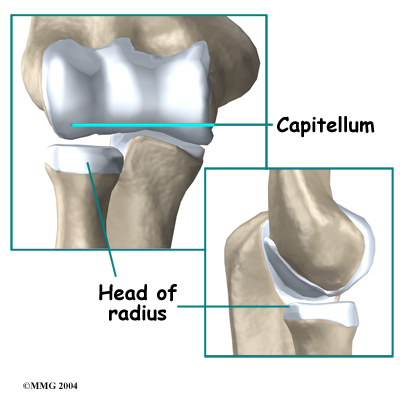
In the elbow, two of the most important ligaments are the medial collateral ligament and the lateral collateral ligament. The medial collateral is on the inside edge of the elbow, and the lateral collateral is on the outside edge. Together these two ligaments connect the humerus to the ulna and keep it tightly in place as it slides through the groove at the end of the humerus. These ligaments are the main source of stability for the elbow. They can be torn when there is a severe injury or dislocation of the elbow. These ligaments are not generally injured in the condition referred to as nursemaid's elbow.
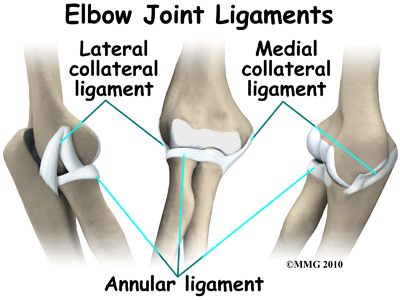
There is also an important ligament called the annular ligament that wraps around the radial head and holds it tight against the ulna. The word annular means ring-shaped. The annular ligament forms a ring around the radial head as it holds it in place. This ligament can be torn when the entire elbow or just the radial head is dislocated.
Causes
How does this problem develop?
In young children, the annular ligament of the radial head is thin and weak. A sudden pull on the forearm can tear this soft tissue structure. The radial head is pulled down through the tear. The annular ligament slips into the radiohumeral joint and becomes trapped between the two joint surfaces when the arm is let go. This is a radial head subluxation. When the annular ligament is pinched it causes pain.
This is a common injury in children. A sudden jerk on the arm is the main cause. As mentioned, lifting the child up a step by the hand, giving the hand a sudden jerk, or pulling the child by the hand or forearm away from a dangerous situation can result in an elbow injury of this type. Playing with other children where one child swings the other around by the arms can also result in this injury. The term ‘nursemaid’s elbow’ dates back to when nursemaids or nannies were the common caregivers who would be minding the children and most commonly holding onto their hands.
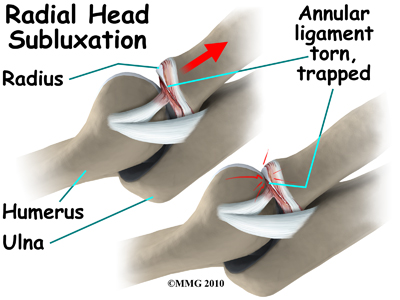
As a child gets older, a true elbow dislocation is more common and is often the result of a fall or trauma (rather than just a pull on the hand) which leads to fracture and dislocation. This is a much different and much more serious injury than nursemaid’s elbow. The most common site of the fracture associated with dislocation in this age group is a supracondylar fracture. The fracture is located below the humeral shaft (upper arm bone) where the olecranon (the tip of the elbow) fits into the humerus. The bone is thin here in children.
Symptoms
What does nursemaid's elbow feel like?
These injuries commonly occur in children too young to actually tell a parent or health care provider what happened. In young children, crying and refusing to use the arm while holding it against the body are common behaviors associated with nursemaid's elbow. Pediatricians, family physicians, orthopedic surgeons and physical therapists usually recognize the pattern quickly because the injury is so common. Once a health care professional has seen a child with this condition, it is relatively easy to spot.
Pain and an inability to straighten the elbow or supinate the forearm (turn the palm up) are typical. There is often tenderness along the lateral aspect of the elbow (side of the elbow away from the body). Bruising around the elbow several days after the injury is common.
In contrast, if the elbow is fully dislocated, it will look out of joint. There may be dimples or indentations of the skin over the dislocation where the bones have shifted position. Swelling on either side of the elbow may be a sign that there is a bone fracture. Pain can be intense until the arm is relocated.
Diagnosis
How do health care professionals diagnose the problem?
Diagnosis begins with a complete history and physical examination. Your physical therapist at Northern Rehab will ask questions about when the pain began, what your child was doing when the pain started, and what movements your child has avoided since the injury occurred. The history alone will often lead your physical therapist to the suspicion of nursemaid’s elbow. Next your physical therapist will do a physical examination of the elbow. They may move the elbow passively to assess the range of motion deficits. Movement with this injury can be very painful, especially as the elbow is extended and supinated. This is another sign that nursemaid’s elbow is the likely cause. Lastly, we will also check for any signs of injury to the nerves or blood vessels.
If your physical therapist deducts from the history and physical examination that nursemaid’s elbow is the likely cause of your child’s pain, we will refer you on to your doctor or emergency room for reduction of the joint back into place and possible x-rays.
Northern Rehab provides services for physical therapy in Mount Airy.
Our Treatment
Reduction of the joint means that the joint is put back into normal alignment. Closed reduction refers to the fact that the subluxation of the annular ligament and radial head are put back in place without surgery. Generally this procedure is done in a clinic or hospital setting.
The technique of reduction is relatively simple. Once your child is calm and trust is established, the elbow is gently taken through a full range of motion from completely extended to fully flexed. While flexed the forearm is maximally supinated. In some cases, a small pop is felt or heard. This can indicate that the radial head and annular ligament have returned to their normal position. After relocation your child is encouraged to use the arm. In many cases, within minutes your child will be using the arm normally. If the child needs to feel more secure, a light splint can be used for a day or two.
It is also possible for the nursemaid's elbow to relocate by itself even before you seek medical aid.
X-rays are consistently negative in children with elbow subluxation or dislocation due to the large amount of fibrous cartilage present around the elbow before the bones are fully formed. It is easy to misinterpret the irregular or fragmented growth lines as fractures. Additional views may be needed to help the radiologist make an accurate diagnosis. Before age five (when the bones start to ossify or become bony) a separation of the growth plate at the end of the bone may go undetected. Many doctors, however, will not even order X-rays if they suspect nursemaid's elbow but will simply try to reduce the subluxation with a gentle manipulation.
If your child continues to exhibit pain after manipulation, however, X-rays may be ordered to make sure that no other injuries are present in the elbow such as a fracture. If the X-rays are normal, then your child will be placed in a sling to rest the painful elbow and will be observed for several days. They will then likely be scheduled to return for re-evaluation in 7-10 days. Over time, the vast majority of cases of nursemaid's elbow resolve spontaneously and only in rare circumstances require any additional treatment.
Rehabilitation
What can be expected from treatment at Northern Rehab?
Nonsurgical Rehabilitation
Often, if the reduction of the joint is uncomplicated, then as mentioned above, most children require no additional treatment and they are simply just encouraged to use the arm normally. If, however, your child continues to suffer from pain or lack of range of motion after the joint has been reduced (and a fracture has been ruled out,) physical therapy is recommended. Northern Rehab provides services for physical therapy in Mount Airy.
Initially, the treatment we provide will be focused on relieving any pain your child has. In the clinic we may use modalities such as ice, heat, or taping and will educate you on the use of these modalities at home as well. Taping the elbow can assist in modifying the alignment of the joint and in doing so, decrease the pain your child feels when using the elbow or being active. We may also use other electrical modalities to help treat the pain if we feel it is necessary.
The next part of our treatment will focus on normalizing any deficits that may have developed in the range of motion and strength of your child’s elbow joint. Your physical therapist at Northern Rehab may assist in stretching your child’s elbow while in the clinic and, if necessary, will ‘mobilize’ the joint. This hands-on technique encourages stiff joints to move gradually into their normal range of motion. In addition to the hands-on treatment in the clinic we will also prescribe a series of stretching exercises that we will encourage your child to do as part of a home exercise program. Being that the most common age to suffer nursemaid’s elbow is from two to eight, these exercises will be simple activities that you can incorporate into the everyday activities of your child. For example, if your child is very young, your physical therapist may show you some simple games that you can play to encourage your child to improve range of motion with daily activity. If they are older, we may teach them a few specific but simple exercises that will again be encouraged throughout regular daily activity.
Similarly to the range of motion deficits, strength deficits will also be addressed. Again, your physical therapist at Northern Rehab will show you how to incorporate strengthening exercises into your child’s normal activities such as playing or eating. Even regular playing with toys, for example, can be used to strengthen your child’s elbow and upper limb.
The final part of our Northern Rehab treatment will be ensuring that your child’s coordination of the limb has returned to normal after the dislocation. Even a short period of abnormal joint use can cause the coordination and proprioception (the ability to know where your body is without looking at it) to decline in function. Exercises, such as weight bearing through the hand, ball tossing, and rotating the forearm will be encouraged throughout playing and everyday activities once your physical therapist determines these are safe activities to undertake. Activities that cause further traction on the elbow, such as pulling a door open or lifting a bag, will be discouraged until full ligamentous healing has occurred, which can take up to 6 weeks depending on the severity of injury.
Education is a fundamental part of our treatment at Northern Rehab therefore It is worthy to mention that parents of small children are cautioned to avoid pulling or lifting by the hand to prevent injuries or re-injuries of this type. Young children should always be picked up under the arms, especially if they have previously had a nursemaid’s elbow injury. Children should never be forcibly pulled, lifted or swung through the air by the hand or wrist.
Fortunately, gaining lost range of motion, strength, and coordination goes quickly after suffering from nursemaid’s elbow. You will notice improvements in your child’s elbow function even after just a few treatments with your physical therapist at Northern Rehab. If your child’s pain continues longer than it should or therapy is not progressing as your physical therapist at Northern Rehab would expect, we will ask you to follow-up with your child’s doctor to confirm that there are no complications that may be impeding your child’s recovery. Generally, however, children respond very well to the physical therapy we provide at Northern Rehab. Under the supervision of one of our physical therapists your child should be back to the daily activities they enjoy in no time.
Northern Rehab provides services for physical therapy in Mount Airy.
Portions of this document copyright MMG, LLC.


